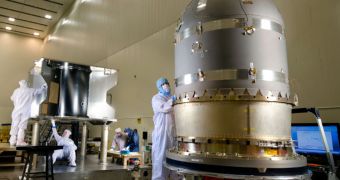Officials at the Littleton, Colorado-based Lockheed Martin Corporation have recently announced that the propellant tank for NASA's upcoming Mars-bound orbiter has just been integrated with the rest of the spacecraft platform.
The company is the main contractor on this project, which is being managed by the NASA Jet Propulsion Laboratory, in Pasadena, California. The mission is called Mars Atmosphere and Volatile EvolutioN (MAVEN), and its main mission will be to understand the Martian atmosphere.
One of the most important mysteries that the spacecraft will try to reveal is the manner in which the loss of volatile chemicals in the Martian atmosphere affected the planet's evolution through time. In addition, it will also need to reveal more data on the planet's upper atmosphere.
Determining how this layer interacts with, and responds to, solar winds is extremely important, planetary scientists say. MAVEN will have to study the isotope ratios through the Martian atmosphere as well, and figure out if neutral gases and ions continue to escape into space even now.
“MAVEN will determine how much of the Martian atmosphere has been lost over time by measuring the current rate of escape to space and gathering enough information about the relevant processes to allow extrapolation backward in time,” a NASA press release explains.
The American space agency plans to launch the mission sometime between November 18 and December 7, 2013, when the next window of opportunity for a Mars-bound travel opens. MAVEN will be carried to orbit aboard the Atlas V 401 delivery system.
The MAVEN principal investigator is Bruce Jakosky, who is based at the Laboratory for Atmospheric and Space Physics at the University of Colorado in Boulder (UCB). He is leader of the UCB team within the NASA Astrobiology Institute.
This mission is one of the last Mars exploration programs currently going on at NASA. Due to lack of funding and extra budget cuts in the planetary exploration division, the agency is unlikely to conduct other Mars-oriented missions until it completes the Orion spacecraft and SLS rocket, in 2017.

 14 DAY TRIAL //
14 DAY TRIAL //